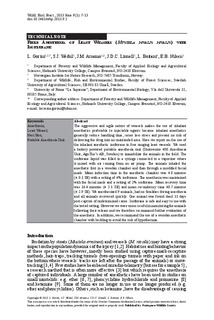Field Anesthesia of Least Weasels (Mustela nivalis nivalis) with Isoflurane
Journal article, Peer reviewed
Permanent lenke
http://hdl.handle.net/11250/134638Utgivelsesdato
2013Metadata
Vis full innførselSamlinger
Originalversjon
Gorini, L., Wedul, S. J., Arnemo, J. M., Linnell, J. D., Boitani, L., Nilsen, E. B., . . . Slagsvold, T. (2013). Field Anesthesia of Least Weasels (Mustela nivalis nivalis) with Isoflurane Wildlife Biology in Practice, 9(1), 7-13. doi: 10.2461/wbp.2013.9.2Sammendrag
The aggressive and agile nature of weasels makes the use of inhalant anesthetics preferable to injectable agents because inhalant anesthetics generally reduce handling time, cause less stress and present no risk of delivering the drug into an unintended area. Here we report on the use of the inhalant anesthetic isoflurane in free ranging least weasels. We used a battery powered portable anesthesia unit (Uninventor 400 Anesthesia Unit, AgnTho’s AB, Sweden) to immobilize the animals in the field. The isoflurane liquid was filled in a syringe connected to a vaporizer where it mixed with air coming from an air pump. The animals inhaled the anesthetic first in a wooden chamber and then through a modified facial mask. Mean induction time in the anesthetic chamber was 4.8 minutes
(± 0.3 SE) with a setting of 4% isoflurane. The anesthesia was maintained with the facial mask and a setting of 2% isoflurane. Mean recovery time was 16.4 minutes (± 2.1 SE) and mean recumbency time 40.7 minutes
(± 2.9 SE). We anesthesized 9 animals, had no fatalities during anesthesia and all animals recovered quickly. One animal was found dead 11 days post-capture of undetermined cause. Isoflurane is safe and easy to use with the tested setting. However we were unsuccessful in monitoring the animals following their release and we therefore recommend further evaluation of the anesthetic. In addition, we recommend the use of a wooden anesthetic chamber with bedding to avoid the risk of hypothermia.
